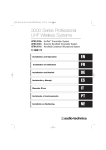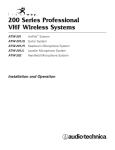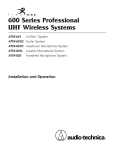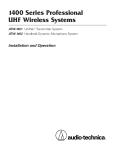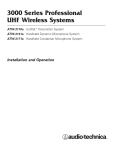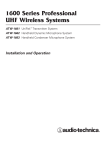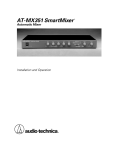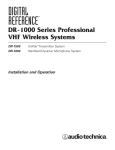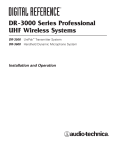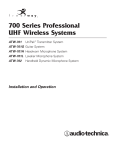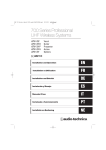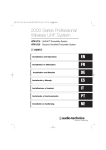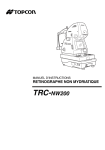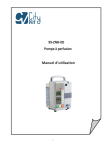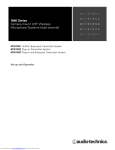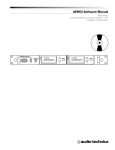Download Audio Technica 200 Series Specifications
Transcript
4000 & 5000 Series Professional UHF Wireless Systems Installation and Operation Professional UHF Wireless Systems Installation and Operation This device complies with part 15 of the FCC Rules. Operation is subject to the condition that this device does not cause harmful interference. This device complies with INDUSTRY CANADA R.S.S. 210, en conformité avec IC: RSS-210/CNR210. Operation is subject to the following conditions: 1) This device may not cause harmful interference and 2) this device must accept any interference received, including interference which may cause undesired operation. Warning: To prevent fire or shock hazard, do not expose this appliance to rain or moisture. Attention: Pour prévenir feu ou choc électrique, ne pas exposé l’appareil à la pluie ou à l’humidité. CAUTION: For continued protection against fire hazard, replace only with same type/rating of fuse. AVIS: Pour poursuivre la protection contre le feu, replacez la fusible de même type/cote. CAUTION! The circuits inside the receiver and transmitter have been precisely adjusted for optimum performance and compliance with federal regulations. Do not attempt to open the receiver or transmitter. To do so will void the warranty, and may cause improper operation. WARNING: There are some sharp edges inside. To reduce the risk of injury, do not remove cover. ATTENTION: Bord tranchant à l’intérieur. Pour réduire le risque de blessure, ne pas ouvir le couvercle. CAUTION RISK OF ELECTRIC SHOCK DO NOT OPEN AVIS RISQUE DE CHOC ÉLECTRIQUE NE PAS OUVRIR To prevent electric shock, do not remove the cover. There are no user-serviceable parts inside. Internal adjustments are for qualified professionals only. Refer all servicing to qualified service personnel. Pour prévenir un choc électrique, ne pas ouvrir le couvercle. Il n’y aucune pièces de rechanges à l’intérieur. Tout ajustement interne doit être fait par une personne qualifié seulement. Référez tout réparation au personnel qualifié. WARNING: This apparatus must be grounded. This product is a safety class 1 product. There must be an uninterruptible safety earth ground from the main power source to the product’s AC input. Whenever it is likely that the protection has been impaired, disconnect the power cord until the ground has been restored. Notice to individuals with implanted cardiac pacemakers or AICD devices: Any source of RF (radio frequency) energy may interfere with normal functioning of the implanted device. All wireless microphones have low-power transmitters (less than 0.05 watts output) which are unlikely to cause difficulty, especially if they are at least a few inches away. However, since a “body-pack” mic transmitter typically is placed against the body, we suggest attaching it at the belt, rather than in a shirt pocket where it may be immediately adjacent to the medical device. Note also that any medical-device disruption will cease when the RF transmitting source is turned off. Please contact your physician or medical-device provider if you have any questions, or experience any problems with the use of this or any other RF equipment. ATTENTION: Cet appareil doit être mise à la terre. Cet appareil est de classe de sûreté 1. Il doit y avoir un ininterrompable de mise à la terre de sécurité provenant de la source principale de courant de l’appareil de l’entrée du courant alternatif. Quand la protection a été affaiblie, débrancher le fil de courant jusqu’à la mise à terre a bien été réétablie. The detachable IEC type power cords supplied are intended for use in regions with mains voltage in the range of 100–125VAC only. Use only the furnished power cord that includes the appropriate NEMA 5-15P/ANSI C73.11 type attachment plug. For use in geographical areas with mains voltage outside of the range 100–125VAC, it is necessary for the user to utilize a power cord rated and configured for operation in their region. Replace the supplied power cord with a cord rated for correct voltage operation. 3 Contents Introduction ....................................................................................................................................6 System Configurations ............................................................................................................6 Operating Frequencies ............................................................................................................7 Receivers ..................................................................................................................................7 Multi-channel Systems ............................................................................................................8 Transmitters ..............................................................................................................................8 Receiver Installation........................................................................................................................8 Location ....................................................................................................................................8 Output Connections..................................................................................................................8 Antennas ..................................................................................................................................8 Antenna Power ........................................................................................................................8 Front-mount Antennas ..............................................................................................................9 Headphone Jack ......................................................................................................................9 Power Connections ..................................................................................................................9 “Link” Connections ..................................................................................................................9 Ethernet Connections (AEW-R5200 only) ..............................................................................10 Receiver Controls and Functions ................................................................................................10 AEW-R5200 Front Panel Controls and Functions ..................................................................10 AEW-R5200 Rear Panel Controls and Functions ....................................................................11 AEW-R4100 Front Panel Controls and Functions ..................................................................12 AEW-R4100 Rear Panel Controls and Functions ....................................................................13 Common Receiver Controls ........................................................................................................14 Power On/Off ........................................................................................................................14 Level Alert Light (LED)............................................................................................................14 LCD Window ..........................................................................................................................14 Mode/Set Button ....................................................................................................................14 Up/Down Arrow Buttons ........................................................................................................14 Changing Receiver Settings ........................................................................................................14 Menu Mode ............................................................................................................................14 Edit Mode ..............................................................................................................................14 Quitting and Saving Changes ................................................................................................14 Receiver Controls and Functions ................................................................................................15 IntelliScan™ Channel Assignment System ..............................................................................15 Receiver Locks ......................................................................................................................15 Antenna Power ......................................................................................................................15 Digital Tone Lock™ Squelch ....................................................................................................15 Meter Hold..............................................................................................................................16 Using “PRESET” Store and Recall ........................................................................................16 Receiver Functions (Chart) ..........................................................................................................17 Transmitter Controls and Functions............................................................................................18 LCD Window ..........................................................................................................................18 Power/Mute Button ................................................................................................................18 Power On/Off ........................................................................................................................18 Mute On/Off ..........................................................................................................................18 Power/Mute Locks ................................................................................................................19 Audio Input Selector (UniPak™ Transmitter) ............................................................................19 Setting Audio Input Level ......................................................................................................19 Preset/Default Settings ..........................................................................................................20 4 UniPak Transmitter Functions (Chart) ........................................................................................21 Handheld Transmitter Functions (Chart) ....................................................................................21 Transmitter Setup..........................................................................................................................22 Battery Selection and Installation ..........................................................................................22 Battery Condition Indicator ....................................................................................................22 UniPak Transmitter Input Connection ....................................................................................23 UniPak Transmitter Antenna ..................................................................................................23 Handheld Transmitter Antenna ..............................................................................................23 UniPak Transmitter Mounting Clip ..........................................................................................23 System Operation ........................................................................................................................24 Selecting/Setting Receiver Frequency....................................................................................24 Setting Receiver Frequency Manually ....................................................................................24 Setting Receiver Frequency Using IntelliScan™ ......................................................................25 Setting Transmitter Frequency................................................................................................26 Setting Transmitter Audio Input Level ....................................................................................26 RF Power Adjustment ............................................................................................................26 RF Interference ......................................................................................................................26 Specifications ................................................................................................................................27 Optional System Accessories ......................................................................................................28 Artist Elite Wireless Operating Frequencies/Groups ................................................................29 Serial Number Log ........................................................................................................................31 Warranty Statement ....................................................................................................................32 Guide to Illustrations Receiver Location (Figure A) ..................................................................................................8 Connecting Linked Receivers (Figure B)................................................................................9 AEW-R5200 Front Panel Controls and Functions (Figure C)................................................10 AEW-R5200 Rear Panel Controls and Functions (Figure D) ................................................11 AEW-R4100 Front Panel Controls and Functions (Figure E)................................................12 AEW-R4100 Rear Panel Controls and Functions (Figure F) ................................................13 Receiver LCD Window (Figure G)........................................................................................13 Transmitter LCD Window (Figure H)....................................................................................18 UniPak™ Transmitter Exterior (Figure J)................................................................................18 Handheld Transmitter Exterior (Figure K) ............................................................................18 UniPak™ Transmitter Battery Door (Figure L) ......................................................................22 Installing Batteries in UniPak™ Transmitter (Figure M) ........................................................22 Opening Handheld Transmitter (Figure N) ..........................................................................22 Handheld Transmitter Interior Controls (Figure P) ..............................................................22 Installing Batteries in Handheld Transmitter (Figure Q) ......................................................22 Receiver Frequency/Group Display (Figure R) ....................................................................25 5 Introduction Thank you for choosing an Audio-Technica professional wireless system. You have joined thousands of other satisfied customers who have chosen our products because of their quality, performance and reliability. This Audio-Technica wireless microphone system is the successful result of years of design and manufacturing experience. IntelliScan™ Channel Assignment System The IntelliScan™ automatic channel assignment system, provided on both the 4000 and 5000 Series receivers, greatly simplifies the selection of usable frequencies in a multi-channel wireless system. The receivers are first linked together with included communication cables. The selected “Master” receiver then “knows” how many total channels it is looking for. It can scan the available frequencies, checking for local interference sources, selecting a group of channels that will all work together (using a built-in frequency plan), and automatically setting the other receivers accordingly. Once this procedure is completed, it’s just a matter of setting the transmitter frequencies to match those of the receivers. Recent advances in the quality and sophistication of professional live-sound systems have been nothing short of revolutionary. Tours, clubs, broadcast events, corporate facilities and worship venues sound better than ever, utilizing better system design and better components in the audio chain. That’s why Audio-Technica has been partnering with industry professionals on the front line of this revolution – the top touring companies, award show designers, FOH and monitor engineers, audio consultants and artists – to learn what it takes to make the best-sounding, most reliable and consistent microphones for the live-sound industry. Artist Elite Transmitters Transmitter models in the Artist Elite Series include: A UniPak™ body-pack transmitter: • AEW-T1000 We listened carefully. Then, we applied this knowledge to the creation of the Artist Elite® line of high-performance microphones and wireless systems. Our ultimate design goal was this: Each model must extend the performance of a sound system, not limit it. Four handheld mic/transmitters with different Artist Elite microphone capsules: • AEW-T3300 • AEW-T4100 Artist Elite Receivers Artist Elite 4000 Series and 5000 Series wireless systems by Audio-Technica share a range of transmitters in common, both body-pack and handheld types. The difference between the two series is simply in the choice of receiver: 4000 Series 5000 Series UniPak™ body-pack transmitter • AEW-T5400 • AEW-T6100 AEW-R4100 half-rack single receiver with multi-unit, multi-channel control linking. Handheld mic/transmitter with AEW-C3300 cardioid condenser capsule Handheld mic/transmitter with AEW-C4100 cardioid dynamic capsule Handheld mic/transmitter with AEW-C5400 cardioid condenser capsule Handheld mic/transmitter with AEW-C6100 hypercardioid dynamic capsule All components in the 4000/5000 Series may be used together in a variety of unit combinations and system configurations to create extremely flexible and powerful solutions for a variety of applications. AEW-R5200 full-rack independent dual receiver with multi-unit, multi-channel control linking, plus Ethernet computercontrol connection, and software for graphical user interface. 4000 Series System Configurations System Transmitter Receiver UniPak™ Handheld Body-pack Condenser Dynamic AEW-R4100 AEW-T1000 — — AEW-4230 AEW-R4100 — AEW-T3300 — AEW-4240 AEW-R4100 — — AEW-T4100 AEW-4250 AEW-R4100 — AEW-T5400 — AEW-4260 AEW-R4100 — — AEW-T6100 AEW-4313 AEW-R4100 AEW-T1000 AEW-T3300 — AEW-4314 AEW-R4100 AEW-T1000 — AEW-T4100 AEW-4315 AEW-R4100 AEW-T1000 AEW-T5400 — AEW-4316 AEW-R4100 AEW-T1000 — AEW-T6100 Body-pack System AEW-4110 Handheld Systems Two-Transmitter Systems Note: All model numbers have an additional letter at the end to indicate frequency band. 6 5000 Series System Configurations System Receiver Transmitter UniPak™ Handheld Body-pack Condenser Dynamic AEW-R5200 AEW-T1000 (2) — — AEW-5233 AEW-R5200 — AEW-T3300 (2) — AEW-5244 AEW-R5200 — — AEW-T4100 (2) AEW-5255 AEW-R5200 — AEW-T5400 (2) — AEW-5266 AEW-R5200 — — AEW-T6100 (2) AEW-T3300 — Dual Body-pack System AEW-5111 Dual Handheld Systems Dual Systems with Body-pack and Handheld Transmitters AEW-5313 AEW-R5200 AEW-T1000 AEW-5314 AEW-R5200 AEW-T1000 — AEW-T4100 AEW-5315 AEW-R5200 AEW-T1000 AEW-T5400 — AEW-5316 AEW-R5200 AEW-T1000 — AEW-T6100 AEW-T3300 (2) — Dual Systems with Pairs of Body-pack and Handheld Transmitters AEW-5413 AEW-R5200 AEW-T1000 (2) AEW-5414 AEW-R5200 AEW-T1000 (2) — AEW-T4100 (2) AEW-5415 AEW-R5200 AEW-T1000 (2) AEW-T5400 (2) — AEW-5416 AEW-R5200 AEW-T1000 (2) — AEW-T6100 (2) Note: All model numbers have an additional letter at the end to indicate frequency band. Operating Frequencies 4000/5000 Series systems and components operate on 200 frequencies in one of two 25 MHz-wide UHF frequency ranges: • Band C 541.500–566.375 MHz (TV Channels 25–30) • Band D 655.500–680.375 MHz (TV Channels 44–49) For simplicity, model numbers used throughout this manual will reference only the basic model number without the “C” or “D” band indications. Artist Elite Series components feature an advanced digital Tone Lock™ squelch system and unique Dual Compander design (patents pending). As a result, Artist Elite Series transmitters and receivers must be used together in Tx-Rx pairs and should not be mixed with components from other Audio-Technica wireless systems, or with those of other manufacturers. All Artist Elite Series components feature soft-touch controls for quick, easy access to a formidable range of functions; an LCD information display in each unit provides convenient visual indication of unit settings and operation. Digital data sent by the transmitters is available for display on the receivers. Both receivers offer a choice of 200 operating frequencies in a 25 MHz-wide UHF frequency range. AEW wireless are designed with a channel spacing that exceeds the transmitters’ maximum modulation deviation, so even adjacent channels are actually usable, unlike some other wireless systems on the market. (For operation of two or more systems at the same time, use the IntelliScan function for frequency selection or, if setting the frequencies manually, use frequencies that are within the same IntelliScan groups listed on page 30.) AEW-R4100: A single synthesized UHF receiver in a half-rack 1U case. Its power supply operates on 100–240V 50/60 Hz AC power worldwide with the appropriate IEC-type power input cordset. AEW-R5200: Two independent synthesized UHF receiver channels in a full-rack 1U case. Its common power supply operates on 100–240V 50/60 Hz AC power worldwide with the appropriate IEC-type power input cordset. In addition, a “pass-through” AC outlet on each receiver with included AC jumper cable permits daisy-chaining of an entire AEW-R5200 receiver stack, freeing AC outlets for other equipment. Receivers Both Artist Elite receiver models feature True Diversity reception. Two antennas feed two completely independent RF sections on the same frequency; automatic logic circuitry continuously compares and selects the superior received signal, providing better sound quality and reducing the possibility of interference and dropouts. 7 Multi-channel Systems Artist Elite systems provide extensive monitoring and control facilities. Transmitter data, in addition to being available at the transmitter, is conveyed in digital form to and displayed on the associated receiver. Linked systems: Both Artist Elite receivers provide linking jacks and cables. AEW-R4100 and AEW-R5200 receivers may be combined in linked multi-channel systems, if desired. Ethernet-based monitoring and control (AEW-R5200): Some wireless systems on the market offer remote control/monitoring of the receiver via a serial interface, but the Audio-Technica AEW-R5200 receiver takes this a significant step further by including control over IP using standard networking protocol and Ethernet interfacing. This permits receivers in a system to be integrated, monitored and controlled from a single computer in real-time. And not only can an individual channel of an individual receiver be examined and its settings modified: if the transmitter on that channel is activated, thanks to the digital data link, data from the associated transmitter can also be monitored. Because standard control over IP is used, Ethernet-connected AEW systems can range from a single laptop controlling a free-standing multi-channel system, to local area network-based systems, to systems controlled via the Internet, even from great distances. Complete setup and operating information for computer-connected AEW systems will be found in the separate Computer Interface manual provided with AEW-R5200 receivers and 5000 Series systems. Transmitters The versatile AEW-T1000 UniPak™ body-pack transmitter features a metal case and includes field-replaceable helical and flexible-wire antennas. It has both low- and high-impedance inputs plus a bias connection, for use with dynamic and electret condenser microphones, as well as Hi-Z instrument pickups. In addition to its programmable functions, the transmitter includes a three-position sliding control cover to limit access, if desired, to only the Power/Mute button, or to no controls at all, as appropriate for the application and/or user. The handheld microphone/transmitters feature metal-body construction. Four models are available, incorporating a variety of capsules from the Artist Elite wired-microphone series created for professional live-sound venues. All Artist Elite Series transmitters use two 1.5V AA batteries for economical operation and wide availability. The receiver and both transmitters have “fuel gauge” battery condition indicators with low-battery warnings. Please note that in multiple-system applications there must be a transmitter-receiver combination set to a separate frequency for each input desired (only one transmitter for each receiver). Because the wireless frequencies are within UHF TV frequency bands, only certain operating frequencies may be usable in a particular geographic area. Also, only certain of the available operating frequencies may be used together. Operating frequencies and IntelliScan frequency groupings will be found on pages 29-30. (Use of the IntelliScan channel assignment system will determine and set appropriate frequencies automatically.) Receiver Installation Location For best operation the receiver should be at least 3 ft. (1 m) above the ground and at least 3 ft. away from a wall or metal surface to minimize reflections. The transmitter should be at least 3 ft. from the receiver, as shown in Figure A. Keep antennas away from noise sources such as digital equipment, motors, automobiles and neon lights, as well as away from large metal objects. Output Connections There are two audio outputs on the back panel: an XLR Mic Output (25 mV) and a 1/4" (6.3 mm) phone jack Instrument Output (50 mV). The two isolated audio outputs permit simultaneous feeds to two different inputs. AEW-R4100: This receiver offers a balanced XLR Mic jack and an unbalanced Instrument 1/4" TS phone jack. Output levels of both are adjusted by the rear-panel Attenuator (ATTN) switch. AEW-R5200: Since there are two independent channels of receiver in the AEW-R5200, there are two sets of output jacks. All audio outputs on the AEW-R5200 are transformer-isolated and balanced. The ground connections of both outputs on each receiver channel may be interrupted (“lifted”) by use of their associated Ground Lift switch. This permits feeding mixers with different ground levels without an additional external splitter. The Instrument output is a balanced 1/4" TRS jack with “audio +” on the Tip, “audio –” on the Ring and ground (shield) on the Sleeve. The rear-panel Attenuator (ATTN) switch for each receiver channel adjusts levels of both outputs in its channel. Use the appropriate shielded audio cable for connections between the receiver and the input(s) of the mixer or other 8 equipment. Antennas Attach a pair of UHF antennas to the antenna input jacks. The antennas are normally positioned in the shape of a “V” (both 45° from vertical) for best reception. In addition to rotating at the connector, the included half-wave antennas pivot from straight to right-angle. Antennas can be remotely located from the receiver. However, due to signal loss in cables at UHF frequencies, use the lowestloss RF cables practical for any cable runs over 25 feet. RG8type is a good choice. Use only copper-shielded cable, not CATV-type foil-shielded wire. Audio-Technica offers auxiliary antennas, and quality RF cables in four lengths; see the Optional System Accessories section on page 28. Antenna Power The antenna input jacks also can provide +12V DC output on their center pins to power inline RF devices. A maximum of 20 mA can be drawn from each of the jacks. While an accidental short-circuit will not harm the internal 12V supply, make certain that an antenna cable shield does not contact the center conductor. Antenna Power (“ANT.PWR”) is selected (switched on or off) from the LCD menu. (On the AEW-R5200, Antenna Power will be found in the menu on Channel 1 only.) Figure A Receiver Installation Front-mount Antennas AEW-R4100: Provision has been made to move the antenna jacks from the rear to the front of the receiver. However, because this involves opening the receiver case and exposing AC power circuitry, instructions are not included in this manual. A qualified service technician must perform this modification. AEW-R5200: BNC-to-BNC connectors and jumper cables are included with the unit to permit mounting antennas on the front panel. • BNC-BNC through-panel connectors: Remove the nut and lock-washer from each connector. Install the connectors from the front into the two panel holes. Note that the flat on the threaded section must be aligned with the flat in each panel hole. Secure each connector from the back with its lock-washer and nut, tightening the nut firmly. • BNC-BNC cable jumpers: Connect the jumpers to the rear antenna jacks first; then attach them to the BNC connectors on the front panel. Make certain the bayonet twist-rings are fully latched on the connectors at both ends. Headphone Jack A headphone jack on the front panel provides monitoring of the receiver’s output. The 1/4" TRS jack is intended for use with stereo headphones. The Phones Level control affects the headphone jack only. Note: On an operating unit, be careful not to press the Power switch accidentally when inserting a headphone jack or adjusting the headphone level. In addition to interrupting receiver operation, even a momentary loss of power to a single unit within a linked multi-channel system will cause the loss of linking connection to the affected receiver and all those “downstream” from it. AEW-R5200: Press and release the Phones Level control knob to switch headphone monitoring from Channel 1 to Channel 2 and back again. Small, lighted indicators just above the knob show which receiver channel is being monitored. Power Connections The switching power supply is designed to operate properly from any AC power source 100–240V, 50/60 Hz without user adjustment. Simply connect the receiver to a standard AC power outlet, using only an IEC-type input cordset approved for the country of use. Power to the unit is controlled by the front-panel Power switch. AEW-R5200: An auxiliary AC “jumper” (pass-through) outlet is provided on the rear panel, and a ”jumper” power cordset is included, to simplify power connections by “daisy-chaining” an array of AEW-R5200’s. Maximum output from the auxiliary outlet is 5 Amperes, which will easily handle a full complement of AEW-R5200 units. (Continued) All AEW receivers in a linked multi-channel system should be interconnected with included link cables. When the system is properly configured, the “slave” units will “link data in” to the “Master” unit. (See Figure B for an example.) 1. First, decide which receiver will be the “Master” unit. Connect a link cable to the Link In jack only. (In an AEW-R5200, the Channel 1 unit is the Master and Channel 2 becomes the first “slave.”) 2. Connect the free end of the link cable from the Master unit (in #1 above) to the Link Out jack of the desired “next” unit. 3. Connect one end of a new link cable to the Link In jack of the unit in #2 above. 4. Connect the free end of the link cable from the unit in #2 above to the Link Out jack of the desired “next” unit. 5. Continue this process of “daisy-chaining” the system’s receivers together with link cables. The “last” unit in the system will have a cable connected to its Link Out jack, but no connection to its Link In jack. Installing link cables starting with the last slave unit and working toward the Master unit is also acceptable practice. The attachment order of link cables establishes the numerical order of the receivers in the multi-channel system, from the selected Master unit through all the slave units. (In the case of AEW-R5200 receivers, a unit’s Channel 1 always comes before its Channel 2.) In a multi-channel system that includes both models of receivers, it’s common practice to position all the AEW-R5200 units first in the chain; followed any AEW-R4100 units. Note 1: For the receiver linking to work, all receivers in the system must have AC power applied at the same time, or the Master receiver must be turned on last. Note 2: In addition, if AC power is interrupted or a link connection is broken at any receiver in a linked system, even for an instant, receivers from that unit onward are no longer linked to the system. When all power and linking have been restored, the system must be restarted by turning all the receivers Off, then On (all turned on simultaneously, or the Master receiver must be turned on last). This will re-initialize the system and re-establish all the data links. Figure B LINKS OUT (N/A) AEW-R5200 IN MASTER SLV 1 OUT “Link” Connections Artist Elite Series multi-channel systems can comprise all AEW-R4100, all AEW-R5200, or combinations of AEW-R4100 and AEW-R5200 receivers. The exclusive IntelliScan™ channel assignment system provides easy, automatic scanning of the RF spectrum and assignment of usable, compatible frequencies to all linked AEW receiver channels. AEW-R5200 IN SLV 2 SLV 3 OUT AEW-R5200 IN SLV 5 SLV 4 OUT Both AEW receiver models can be interconnected using Link In/Out jacks and included link cables. In addition, the AEW-R5200 offers a built-in Ethernet 10 BaseT connection, with interface software provided on CD-ROM. See the separate AEW Control Interface manual provided with AEW-R5200 receivers and 5000 Series systems. AEW-R4100 IN SLV 6 OUT AEW-R4100 IN (N/A) SLV 7 9 Receiver Installation Ethernet connections (AEW-R5200): An RJ-45 jack on the rear panel of each AEW-R5200 provides an Ethernet 10 BaseT data/control connection from both of its channels to an external computer system. Data monitored includes actual, real-time “RF” and “AF” levels for receiver channels with direct Ethernet connections to the associated computer. All other linked receivers in a system supply control-function access and all their data – except for “RF” and “AF” levels – to the computer connected to the Master receiver. (Continued) Other than being able to “see” the “RF” and “AF” levels, all functions of all receivers in a linked system can be monitored and controlled from the computer connected to the Master receiver. Details of the computer setup and operation will be found in a separate AEW Control Interface manual provided with AEW-R5200 receivers and 5000 Series systems. Multiple AEW-R5200 receivers in a system can each provide real-time “RF” and “AF” levels to the associated computer if each AEW-R5200 has its own Ethernet connection, through an Ethernet hub, to the computer. Receiver Controls and Functions Figure C AEW-R5200 Receiver Front Panel UHF SYNTHESIZED DIVERSITY RECEIVER AEW-R5200 PUSH SEL OUTPUT ON MODE/SET MODE/SET LEVEL RX NAME RX NAME POWER OFF PHONES 13 1 2 MIN MAX 3 4 5 6 Front Panel Controls and Functions (Fig. C) 1 POWER SWITCH: Press Power switch in and the receiver readouts will light. 2 HEADPHONE OUTPUT: 1/4" (6.3 mm) TRS (“stereo”) phone jack. Plug in either a mono or "stereo" headphone to monitor receiver signal. 3 HEADPHONE LEVEL CONTROL / CHANNEL SWITCH: Adjusts the level of the headphone jack only; it does not affect receiver audio output. Press-and-release the knob to switch between Channel 1 and Channel 2. 4 HEADPHONE CHANNEL INDICATOR: Shows which receiver channel is feeding the monitor headphones. Channel 1 / Channel 2 5 / 9 ALERT INDICATOR: The Alert Indicator lights: (a) When the receiver is in the Mute mode, (b) When no RF signal is received from the transmitter, (c) When only one or two RF signal-strength bars are on, (d) When the transmitter is in the Mute mode, (e) When audio modulation level from the transmitter is close to the clipping point (AF +6 bar), or (f) When the “LOW BAT” warning appears in the LCD (transmitter battery is weak). 10 7 8 9 10 11 12 13 6 / 10 LCD WINDOW: Liquid Crystal Display indicates control settings and operational readings. See Figure G on page 13 for details. 7 / 11 UP/DOWN BUTTONS: Press Up or Down arrow button, in conjunction with the Mode/Set button, to step through menus, select operating frequency and edit receiver function choices. 8 / 12 MODE/SET BUTTON: Use in conjunction with the Up/Down arrow buttons to step through menus, choose operating frequency and select receiver function options. 13 FRONT-MOUNT ANTENNAS: Cables and panel connectors are included with the AEW-R5200 to permit attaching antennas at the front panel. Receiver Controls and Functions (Continued) Figure D AEW-R5200 Receiver Rear Panel IN BALANCED MIC OUTPUT INSTRUMENT IN 0/-6/-12 ANT. B 31 14 0/-6/-12 NETWORK INTERFACE ATTN (dB) EXTERNAL MUTE 15 OUTPUT GROUND LIFT (BAL) 16 17 BALANCED MIC OUTPUT INSTRUMENT 18 ANT. A 19 20 21 Rear Panel Controls and Functions (Fig. D) 14 ANTENNA INPUT JACK: BNC-type antenna connector for Tuner “B.” Attach the antenna directly, or extend it with a low-loss antenna cable. See the ”Antennas” section on page 8 for more details. Antenna power at +12 volts is available at both antenna jacks; select it via the LCD menu on Channel 1. 15 / 22 EXTERNAL MUTE: Permits manual and absolute muting of the receiver via a 1/4" TS phone jack and a userprovided external switch. “Shorting” the jack (closing the switch connection) mutes the receiver channel. When External Mute has been applied, the only way to un-mute the receiver is to open the External Mute switch connection. 16 / 23 INSTRUMENT OUTPUT JACK: 1/4" transformer-isolated TRS balanced phone jack output. Tip: “audio +”; Ring: “audio –”; Sleeve: ground (shield). Can be connected to an aux-level input of a mixer, guitar amp or tape recorder. Using the associated Ground Lift switch permits feeding equipment with different ground levels. 17 / 24 AF OUTPUT ATTENUATOR: Three-position switch adjusts audio output level of both audio output jacks, with attenuation of 0 dB, –6 dB or –12 dB. 18 / 25 MIC OUTPUT JACK: XLRM-type connector. Pin 1: ground (shield); Pin 2: “audio +”; Pin 3: “audio –”. A standard 2-conductor shielded cable can be used to connect the receiver output to a balanced microphone-level input on a mixer or integrated amplifier. This output is transformerisolated from the 1/4" TRS Instrument output jack. 19 / 26 GROUND LIFT SWITCH: Disconnects the ground of both the Mic and Instrument output jacks on the associated receiver channel. Normally, the switch should be to the right (ground connected). If hum caused by a ground loop occurs, slide switch to the left (ground lifted). LINK OUTPUT 5A/500W MAX OUT WARNING: THIS APPARATUS MUST BE EARTHED. ATTN (dB) EXTERNAL MUTE GROUND AC ˜ 100V-240V 50/60Hz IN OUTPUT GROUND LIFT (BAL) 22 23 24 25 GROUND 26 27 28 29 30 31 20 NETWORK INTERFACE CONNECTOR: An Ethernet connection on the AEW-R5200 provides full communication and monitor/control by an associated computer. See the separate AEW Control Interface manual for computer setup and operation. 21 ANTENNA INPUT JACK: Connector for Tuner “A.” Attach the antenna directly, or extend it with a low-loss antenna cable. 27 LINK IN JACK: Connect the provided cable to this jack with the index mark on the plug aligned toward the screw head to the right of the jack. The receiver with a Link In and no Link Out connection is the “Master” unit. (With an AEW-R5200 in the Master position, its Channel 1 is the system’s Master and its Channel 2 is the first “slave.”) 28 LINK OUT JACK: Connect the provided cable to this jack with the index mark on the plug aligned toward the screw head to the right of the jack. The receiver with a Link Out and no Link In connection is the last slave in a multi-unit system. 29 AUXILIARY AC OUTLET: An auxiliary AC pass-through outlet and included “jumper” power cordset simplify making power connections to an array of AEW-R5200’s. Maximum output from the auxiliary AC outlet is 5 Amperes. 30 AC POWER INPUT: IEC-type connector for 100V–240V AC, 50/60 Hz power input. No adjustment for mains voltage/ frequency is necessary. 31 REAR RACK MOUNT: Mounts are provided at the rear of the side panels to permit attachment to rear rack rails in racks so equipped. The additional support is especially helpful when equipment is transported. 11 Receiver Controls and Functions (Continued) Figure E AEW-R4100 Receiver Front Panel ON POWER ALERT MODE/SET OFF RX NAME PHONES 39 MIN– LEVEL–MAX 33 32 34 35 UHF SYNTHESIZED DIVERSITY RECEIVER AEW-R4100 36 37 38 Front Panel Controls and Functions (Fig. E) 32 POWER SWITCH: Press Power switch in and the receiver readouts will light. 33 HEADPHONE OUTPUT: 1/4" (6.3 mm) TRS (“stereo”) phone jack. Plug in either a mono or “stereo” headphone to monitor receiver signal. 34 HEADPHONE LEVEL CONTROL: Adjusts the level of the headphone jack only; it does not affect receiver audio output. 35 ALERT INDICATOR: The Alert Indicator lights: (a) When the receiver is in the Mute mode, (b) When no RF signal is received from the transmitter, (c) When only one or two RF signal-strength bars are on, (d) When the transmitter is in the Mute mode, (e) When audio modulation level from the transmitter is close to the clipping point (AF +6 bar), or (f) When the “LOW BAT” warning appears in the LCD (transmitter battery is weak). 12 39 36 LCD WINDOW: Liquid Crystal Display indicates control settings and operational readings. See Figure G on page 13 for details. 37 UP/DOWN BUTTONS: Press Up or Down arrow buttons, in conjunction with the Mode/Set button, to step through menus, select operating frequency and edit receiver function choices. 38 MODE/SET BUTTON: Use in conjunction with the Up/Down arrow buttons to step through menus, choose operating frequency and select receiver function options. 39 MOUNTING ADAPTERS: For mounting the receiver in any standard 19" rack. Attach to the receiver with the screws supplied. (Use an optional AT8628a joining-plate kit to mount two AEW-R4100 receivers side by side.) Receiver Controls and Functions (Continued) Figure F AEW-R4100 Receiver Rear Panel BALANCED MIC OUTPUT IN IN INSTRUMENT 0/-6/-12 ATTN (dB) GROUND GROUND LIFT OUTPUT (UNBAL.) 40 AC ˜ 100V-240V 50/60Hz ANT. A ANT. B 41 42 43 44 IN – LINK – OUT 45 46 WARNING: THIS APPARATUS MUST BE EARTHED. 47 48 Rear Panel Controls and Functions (Fig. F) 40 ANTENNA INPUT JACK: BNC-type antenna connector for Tuner “B.” Attach the antenna directly, or extend it with a low-loss antenna cable. See the “Antennas” section on page 8 for more details. 44 GROUND LIFT SWITCH: Disconnects the ground pin of the balanced output jack (43) from ground. Normally, the switch should be to the right (ground connected). If hum caused by a ground loop occurs, slide switch to the left (ground lifted). 41 INSTRUMENT OUTPUT JACK: 1/4" phone jack. Can be connected to an aux-level input of a mixer, guitar amp or tape recorder. On the AEW-R4100, this is an unbalanced TS phone jack. 45 LINK IN JACK: Connect provided cable to this jack with the index mark on the plug aligned toward the screw head above the jack. The receiver with a Link In and no Link Out connection is the “Master” unit. 42 AF OUTPUT ATTENUATOR: Three-position switch adjusts audio output level of both audio output jacks with attenuation of 0 dB, –6 dB or –12 dB. 46 LINK OUT JACK: Connect provided cable to this jack with the index mark on the plug aligned toward the screw head above the jack. The receiver with a Link Out and no Link In connection is the last unit in a multi-unit system. 43 MIC OUTPUT JACK: XLRM-type connector. A standard 2-conductor shielded cable can be used to connect the receiver output to a balanced microphone-level input on a mixer or integrated amplifier. 47 ANTENNA INPUT JACK: Connector for Tuner “A.” Attach the antenna directly, or extend it with a low-loss antenna cable. 48 AC POWER INPUT: IEC-type connector for 100V–240V AC, 50/60 Hz power input. No adjustment for mains voltage/ frequency is necessary. Figure G Receiver LCD Window 54 50 55 56 T X LO T X HI T X LOCK RX LOCK T X NAME RX NAME 49 51 52 53 58 57 59 49 RF SIGNAL LEVEL INDICATOR: Shows the strength of the RF signal received from the transmitter. Also indicates which Tuner (A or B) has the better reception and is in operation. When the METER HOLD function is on, the lowest-level RF signal received from the transmitter is indicated by a flashing bar. 50 ALPHANUMERIC DISPLAY: Shows Receiver Name (57), Transmitter Name (57), or Link Address (MASTER, or SLV and the slave number). The factory setting displays “DEF” in Receiver Name mode (“RX NAME”). Once the settings have been changed, the unit will display the last setting and mode selected. Also flashes the “LOW.BAT” warning when the associated transmitter’s batteries are weak. 51 TRANSMITTER BATTERY INDICATOR: Displays a maximum of four bar segments, with four bars indicating full power. 52 FREQUENCY DISPLAY: Indicates the current frequency setting in MHz. 53 “EDIT”: Appears and flashes when the receiver is in edit mode. 54 TRANSMITTER RF POWER DISPLAY: Indicates either “TX LO” or “TX HI”. 55 “TX LOCK”: Appears when the transmitter is in one of its three lock settings (ALL.LOC, MUT.LOC or PWR.LOC). 56 “RX LOCK”: Appears when the receiver is in one of its three lock settings (ALL.LOC, PC.LOC or RX.LOC). 57 TX/RX NAME: Indicates whether the transmitter name or the receiver name is displaying in the top line of the LCD display. 58 “MUTE”: Appears when the receiver or transmitter is muted, when the receiver is not receiving an audio signal, or when the receiver is externally muted by use of the EXTERNAL MUTE jack. 59 AF LEVEL INDICATOR: Shows the audio modulation level of the received signal. When the METER HOLD function is on, the bar corresponding to the highest level reached will stay 13 lit. Receiver Controls and Functions Receiver Controls Power On/Off Press the power switch to turn the receiver on. After a short power-up sequence, the display shows the operating frequency and the alert light is illuminated (if no active transmitters are present on this frequency). The receiver may also display a system position (i.e., “MASTER”, “SLV-#”) or an assigned transmitter or receiver name (if this feature has been set up—the display recalls the setting from the last time power was applied). Refer to page 16 on setting up receiver names or page 20 on setting up transmitter names. Level This control is used to set a comfortable listening level for the headphone jack. Turn the control clockwise to increase the level. LCD Window The LCD (Liquid Crystal Display) window provides visual indication of key operating and configuration parameters. It is also used in conjunction with the Mode/Set and Up/Down arrow buttons to change user-configurable functions. Alert Light (LED) The alert light illuminates to indicate to the user that something needs attention; for example, the transmitter batteries are low, or the transmitter is muted or turned off. Refer to page 10 for a complete description of alert light indications. Mode/Set Button The Mode/Set button has different functions depending on the status of the receiver. Two distinct operations are associated with this button: Touch: A momentary press of the Mode/Set button. It is used to enter Menu mode, to enter Edit mode, or to Escape without making any changes to current settings. Hold: A press and hold (about two seconds) of the Mode/Set button. It is used to accept a new setting when the receiver is in Edit mode or to save the current settings to one of the five user-defined name presets or the internal memory location (“NAME?”). Up/Down Arrow Buttons The Up/Down arrow buttons are used in conjunction with the Mode/Set button to scroll through the function menu in Menu mode or through the available choices for a given function in Edit mode. When the receiver is in normal operating mode, the Up/Down arrow buttons scroll through Receiver Address (“MASTER” or “SLV-#”), Receiver Preset Name, or Transmitter Preset Name. How to change receiver settings Enter Menu mode With the receiver in the normal operating mode, touch the Mode/Set button. The top line of the receiver display shows “FRQ” preceded by one, two, or three asterisks. Touch the Up/Down arrow buttons to scroll through the available functions that may be changed. (See the chart on page 17 for a list of functions and display indication.) Note that the display’s lower line indicates the current setting for a given function. 14 (Continued) Enter Edit mode When the function to be edited is displayed, touch the Mode/Set button. The small word “EDIT” flashes in the bottom of the display, indicating Edit mode. Touch the Up/Down arrow buttons to scroll through the available choices for the function, stopping on the desired choice. Hold the Mode/Set button to accept the new choice. “STORED” appears in the display when the choice is accepted. The receiver then reverts to Menu mode. Continue this process until all desired function-setting changes are complete. Note: To escape from Edit mode without making any changes, touch the Mode/Set button. “ESCAPE” appears briefly in the display, and the receiver reverts to Menu mode. Quitting and saving changes The receiver has several methods of saving function settings. Each receiver has five loadable user presets that may be given individual names (up to six characters), along with a special, non-loadable memory location called “NAME?” that can store the most recent settings until they are changed. To save a set of receiver function settings, use the Up/Down arrow buttons to scroll until the display shows “QUIT.” The procedure for saving the current settings depends upon the desired location: Saving to the “NAME?” location If the current receiver settings do not need to be identified with a name, the special “NAME?” location may be used to store them. As with the “last number redial” function on a telephone, these settings remain stored in the receiver even if power is turned off. They disappear only if one of the settings is modified. To store settings in the “NAME?” location, touch the Mode/Set button. The display shows “NAME?” for the receiver name. Saving updated settings to the currently loaded user “PRESET#” location To update the receiver settings in the currently loaded user preset that is already named, hold the Mode/Set button. The display shows “STORE XXXXXX” (where XXXXXX indicates the preset’s name). Hold the Mode/Set button a second time. The first character of the name flashes. Hold the Mode/Set button a third time. The display briefly shows “STORED”, and the receiver reverts to normal operation. Receiver Controls and Functions (Continued) Saving to a different user PRESET# location To store settings to a different user preset location, hold the Mode/Set button. The receiver shows “STORE XXXXXX” (where XXXXXX indicates the loaded preset’s name). Receiver Locks Programmable locks restrict the ability to change receiver settings, reducing the possibility of unauthorized access or unintended changes during performances. Touch the Up/Down buttons to scroll to another preset location (the display shows the user-defined name for each location, or “PRESET#” if no name has been assigned). Setting Description NO.LOC Receiver functions and frequency settings can be edited from the receiver’s front panel or from an associated computer via an Ethernet connection to a linked AEW-R5200. ALL.LOC Receiver functions and frequency settings cannot be edited from the front panel or from a computer via an Ethernet connection to a linked AEW-R5200. ALL.LOC must be changed via the receiver’s Menu before other settings can be changed. PC.LOC Receiver functions and frequency settings can be edited from the receiver’s front panel, but they cannot be edited from an associated computer (via an Ethernet connection to a linked AEW-R5200). RX.LOC Receiver functions and frequency settings can be edited from an associated computer (via an Ethernet connection to a linked AEW-R5200), but they cannot be edited from the receiver’s front panel. At the desired preset location, hold the Mode/Set button. The first character of the name becomes the cursor and flashes. Touch the Up/Down arrow buttons to scroll through the characters until the desired character is displayed. Touch the Mode/Set button to accept the character and advance to the next character. To advance the cursor without changing the character, touch the Mode/Set button. After setting the last character, hold the Mode/Set button to store the name and revert to normal operation. Holding the Mode/Set button at any time during the naming process while the cursor is flashing will store the setting and return the receiver to normal operation. Note: To escape the naming process, touch the Mode/Set button repeatedly until the last character is flashing, and then touch the Mode/Set button again to escape. At the flashing “ESCAPE” display, touch the Mode/Set button to go back to the beginning of the name, or hold the Mode/Set button to return to “QUIT.” Note: While the receiver is in Edit mode, no action (no buttons pressed) for approximately 30 seconds causes the receiver to revert to Menu mode. While the receiver is in Menu mode, no action for approximately 30 seconds causes the receiver to revert to normal operating mode. Any setting changes stored will remain in the “NAME?” memory location, and the receiver will display “NAME?” because the settings were not saved to a user preset. This will occur even if a user preset was previously loaded. Receiver Functions IntelliScan™ Channel Assignment System The IntelliScan™ channel assignment system, provided on both the AEW-R4100 and AEW-R5200 receivers, eliminates the trouble and frustration normally encountered while attempting to find and select usable, compatible frequencies in a multichannel system. The Artist Elite receivers are simply connected together with included communication link cables. A “Master” receiver then “knows” how many total channels it is looking for. It can scan the available frequencies, checking for local interference sources, selecting a group of channels that will all work together (using a built-in frequency plan), and automatically setting the other linked AEW receivers accordingly. Once this procedure is completed, the transmitter frequencies must be set to match the receiver frequencies. When any lock condition is applied to a receiver (ALL., RX. or PC.), the LCD window displays a small “RX LOCK” just to the right of the frequency. If an action is attempted that currently is locked out, the LCD will briefly display “LOCKED”, then return to its previously displayed contents. Note: Locks remain in place even when receiver power is turned off. However, locks may be removed by using the Menu. Antenna Power This function turns on the 12V AC antenna power for use with powered antennas or accessories. Digital Tone Lock™ Squelch The Artist Elite Series employs a unique digital Tone Lock squelch system that provides enhanced rejection of interference. In addition to providing highly effective control of unwanted noise, the Tone Lock signal from the transmitter also conveys data with the transmitter’s name (Tx Name), battery condition, mute status and lock status back to the receiver for display. In addition to displaying in the receiver’s LCD window, the data are also displayed on an Ethernetconnected computer. The squelch level is adjustable in fifteen 2 dB steps, providing a 30 dB range. Increasing the squelch level – also called “tightening the squelch” – can cause a reduction in usable range of the wireless transmitter, so use the lowest value that reliably mutes the unwanted RF signals. (If interference is a problem, first consider trying a different frequency, either manually or by scanning.) 15 Receiver Controls and Functions Meter Hold When activated (“METER HOLD”), this function permits the bar meters in the LCD window to capture and display the highestlevel “AF” audio modulation (a solid bar) and the lowest-level “RF” signal (a flashing bar) received from the transmitter. This is particularly useful when setting up the system initially, performing a sound-check, or diagnosing operating problems. The default setting is Off (“METER NORMAL”). When the Meter Hold is On, it is possible to reset it – to obtain a new set of RF and AF readings – without turning it off-and-on using the Menu/Edit functions. Simply press the transmitter’s Power/Mute button once (to mute the transmitter) and wait until the receiver’s Alert light comes on, indicating the Mute condition. Then press the transmitter’s Power/Mute button once again, to un-mute the transmitter. After the Alert light goes out, a new set of min/max RF/AF readings will be indicated on the bar meters. (Note that, depending upon the digital updating-and-confirming sequence of the Mute condition data from the transmitter, it can take from a few to many seconds for the Alert light condition to change. The Meter Hold readings are not reset until the Alert light has turned on, then off.) Note: Any or all of these receiver functions may be stored to, or loaded from, one of the five user presets. Using "PRESET" Store and Recall There are two aspects to Preset operation: Storing a particular collection of settings for future use (“STORE”), and recalling a stored collection of settings (“LOAD”). All Artist Elite receivers and transmitters permit the storing and recalling of up to five user-defined Preset combinations—with customized names, if desired—plus the recalling of the factory-defined Default (“DEF”) settings. While the standard Preset names (“PRSET1” – “PRSET5”) can be used, customized receiver and transmitter identification can simplify system operation, especially in larger systems. For example, a guitar channel’s Rx Name could be “GUITAR”, while the transmitters for the performer’s two different guitars could be named “GTR-1” and “GTR-2”. To store Preset configurations: 1. Touch the Mode/Set button once to move to Menu mode. 2. Touch the Up arrow twice to move to “PRESET” in the LCD window. (The second line of LCD will show currently loaded presets.) 3. Touch the Mode/Set button once. “LOAD” (or “STORE”) appears in the LCD. 4. Touch the Up or Down arrow once, if needed, to change the selection to “STORE.” 5. Hold the Mode/Set button until “PRSET1” (or the name of the currently loaded Preset) appears on the second line of the LCD. 6. If desired, touch the Up or Down arrow to cycle through the available choices: “PRSET1” through “PRSET5” (or their previously changed names). 16 (Continued) 7. Accept or enter a name for the Preset: a. To accept the standard name “PRSET1“ – “PRSET5” (or previously stored name) for a new Preset configuration and to update (overwrite) any previously stored configuration choices: a1. At the desired choice, hold Mode/Set until the first character blinks, giving an opportunity to change the name. a2. To accept the standard (or existing) name, hold the Mode/Set button again until “STORED” appears in the window. This stores the standard or existing Preset name with the associated function choices and returns the unit to normal operation. The name of the stored preset will appear in the top line of the display. b. To enter a custom name for a Preset: b1. At the desired choice, hold the Mode/Set button. The first character blinks. b2. Using the Up or Down arrow, move through the available characters (see box below) until the desired character is reached. Touch an arrow button for single steps, or hold it down to scroll through the characters at increasing speed. b3. Touch the Mode/Set button once to accept the first character and move to the second character, which now is blinking. Use an Up/Down arrow button to find the desired second character; touch the Mode/Set button once to accept it and move to the third position. Repeat this selection process until the character for the sixth position has been selected. b4. Once the sixth character has been selected as desired, hold the Mode/Set button until “STORED” appears in the window. This stores the custom Name with the associated function choices and returns the unit to normal operation. The display shows the custom name in the top line. Note: If a correction or change is desired while entering characters, simply touch the Mode/Set button once when the sixth (last) character has been reached. The window will flash “ESCAPE.” Touch the Mode/Set button once more to start the name-entry process over at the first character. (To leave any characters as they are, simply touch Mode/Set once to skip over them.) Available receiver Name character choices: A …through… Z, __ (underscore) … (space) … [ (left bracket) … ] (right bracket), * … + … -- … / , 0 …through… 9, | … < … > … ? Receiver Controls and Functions (Continued) To load (recall) a Preset: 1. Touch the Mode/Set button once to move to Menu mode. To revert to factory-default values: 1. Touch the Mode/Set button once to move to Menu mode. 2. Touch the Up arrow twice. LCD top line shows “PRESET.” 2. Touch the Up arrow twice. “PRESET” shows in the LCD window. 3. Touch the Mode/Set button once. “LOAD” (or “STORE”) appears in the LCD. 4. If needed, touch the Up arrow once to change the selection to “LOAD.” 5. Hold the Mode/Set button. The name of the currently loaded Preset appears on the second line of the LCD. 6. Touch the Up or Down arrow to cycle through the available choices, stopping on the desired choice. 7. Hold the Mode/Set button until “LOADED” appears briefly in the LCD. The receiver reverts to normal operation with the selected preset’s functions loaded. The top display line indicates the loaded preset and the bottom line the current frequency. 3. Touch the Mode/Set button once. “LOAD” (or “STORE”) appears in the LCD. 4. Touch the Up arrow once, if needed, to change the selection to “LOAD.” 5. Hold the Mode/Set button. The name of the currently loaded Preset appears on the second line of the LCD. 6. Touch the Up/Down arrow buttons to cycle through the available choices until “DEF” appears in the display. 7. Hold the Mode/Set button to load the factory default settings. “LOADED” appears briefly in the LCD. The receiver then reverts to normal operation at factory-default values. “DEF” appears in the upper line of the LCD. Note: Loading the default setting will also revert the receiver frequency to the default value of 541.500 (Band C) or 655.500 (Band D). Receiver Functions Function Menu Default Value Choices (Edit) ▲▼ ▲▼ Frequency Lowest in band† 200 discrete frequencies ▲▼ Scan**/*** No value Scan start ▲▼ Lock NO.LOC NO.LOC ALL.LOC PC.LOC RX.LOC Yes ▲▼ Antenna Power** OFF OFF Yes ▲▼ Squelch - (one bar) 15 steps, 2 dB each No ▲▼ Meter NORMAL NORMAL Yes ▲▼ Preset PRESET Press once, then select LOAD or STORE Yes ▲▼ LOAD: DEF DEF (default), PRSET1 through PRSET5 Yes ▲▼ STORE: PRSET1 PRSET1 through PRSET5 Yes QUIT Press Mode/Set once to exit ▲▼ Quit (exit Menu) Wrap-around* Yes -- ON HOLD -- * Continue in the same Up/Down direction and choices “wrap around” to the other end of the range. ** AEW-R5200: Scan and Antenna Power selections in LCD menu on Channel 1 only. *** Scan selection is not available when the receiver has been linked as a slave unit. † Band C: 541.500 MHz; Band D: 655.500 MHz Table 1. Receiver Functions 17 Transmitter Controls and Functions Refer to Figures H through Q for an overview of transmitter functions and controls. Power On/Off To turn the transmitter on, hold the Power/Mute button until the red power indicator and the LCD window come on (about 1–2 seconds). The operating frequency shows in the window after the power-up sequence. Touch: A momentary press of the Mode/Set button. It is used to enter Menu mode, to enter Edit mode, or to Escape without making any changes to current settings. To turn the transmitter off, hold the Power/Mute button again, until the red power indicator and the LCD window are extinguished (about 1–2 seconds). The LCD window shows “PWR.OFF” before shutdown. Hold: A press and hold (about two seconds) of the Mode/Set button. It is used to accept a new setting when the receiver is in Edit mode or to save the current settings to one of the five user-defined name presets or the internal memory location (“NAME?”). Mute On/Off When the transmitter is muted, it produces RF with no audio signal modulation. When the transmitter is un-muted, it produces both RF and audio. LCD Window The Liquid Crystal Display presents a great deal of setup and operating information clearly and conveniently (Figure H). The LCD in the transmitters is designed for greatest contrast and best viewing with the window rotated somewhat away from the viewer (about 30 degrees), not straight-on, for a more convenient holding/viewing position. To mute the transmitter (cut off the audio, but continue the RF output), touch the Power/Mute button once. A small “MUTE” appears in the LCD window, just below the frequency (Figure H-2). To un-mute the transmitter (restore the audio), touch the Power/Mute button once again. The “MUTE” disappears from the LCD window. Power/Mute Button The transmitters have a combination Power and Mute switch (Figure J/K). When used in combination with the programmed choices explained below, the various functions available to the transmitter user may be tailored to fit personal preferences or particular situations. Figure H Flashing ▼ ▼ EDIT MENU MIC H-1. Normal Operation BATT * MUTE MIC ▼ BATT H-2. Operation with Mute On BATT MIC H-3. Menu Mode (Frequency) BATT H-4. Edit Mode (Frequency) * AEW-T1000 only: “INST” J Figure B Figure K B Power/Mute Button Antenna LCD Window Power-on LED Audio Input Jack Power/Mute Button Up/Down Arrows Sliding Control Cover (3-position) AEW-T1000 UHF TRANSMITTER LCD Window Mounting Clip Set Button Battery Door 18 Antenna Housing MIC Power-on LED Transmitter Controls and Functions Power/Mute Locks Programmable Power/Mute Locks limit the functioning of the Power/Mute button as desired for particular users and/or applications. Power can be locked On; Mute can be locked Off. Selection of the desired locks, if any, is made through the function menu: Setting Description NO.LOC The normal Power and Mute functions are fully operational. ALL.LOC Power is locked On and Mute is locked Off when “ALL.LOC” is applied. When in the ALL.LOC mode, the transmitter may be turned off by (1) re-accessing the .LOC Menu and changing the setting, (2) pressing and holding the Up arrow button and the Set button at the same time, until the power goes off, or (3) removing and re-installing the batteries. When the transmitter is turned on again, it will power up in the NO.LOC mode. MUT.LOC In this mode, the audio cannot be muted (Mute function is locked Off). The Power functioning is unaffected. “Mute” Note: If ALL.LOC or MUT.LOC is applied while the transmitter is muted, pressing the Power/Mute button once will return the transmitter to un-muted operation; thereafter the Mute function is disabled (Mute Off) until the .LOC setting is changed again. PWR.LOC Power is locked On when “PWR.LOC” is applied. The Mute functioning is unaffected. When in the PWR.LOC mode, the transmitter may be turned off by: (1) Re-accessing the .LOC Menu and changing the setting, (2) Pressing and holding the Up arrow button and the Set button at the same time, until the power goes off, or (3) Removing and re-installing the batteries. When the transmitter is turned on again, it will power up in the NO.LOC mode. Note: Only the ALL.LOC or PWR.LOC Power function will change when batteries are removed; NO.LOC and MUT.LOC settings remain stored in memory. (Continued) Audio Input Selector The UniPak™ body-pack transmitter provides input connections for both low-impedance (Lo-Z) microphones and highimpedance (Hi-Z) instruments. A wide range of Audio-Technica Wireless Essentials® microphones and cables is available pre-terminated with the appropriate professional latching connector. (See page 28.) Selection of the desired input – microphone or instrument – is made through the function menu. Depending upon the input selected, a small “MIC” or “INST” will continue to show in the LCD window, just below the frequency. (In the handheld transmitters, “MIC” will always show in the LCD window.) Setting Audio Input Level AEW-T1000 UniPak: A 10-position audio input gain setting, selected through the function menu, serves to match the audio input level to the transmitter for best modulation with minimum distortion. Available choices are +12 dB to –6 dB in 2 dB steps. The default value is +6 dB. AEW-T4100 and AEW-T6100 Dynamic Handhelds: A 4-position audio input gain setting, selected through the function menu, serves to match the audio input level to the transmitter for best modulation with minimum distortion. Available choices are +12 dB to –6 dB in 6 dB steps. The default value is +6 dB. AEW-T3300 and AEW-T5400 Condenser Handhelds: A 3-position audio input gain setting, selected through the function menu, serves to match the audio input level to the transmitter for best modulation with minimum distortion. Available choices are +12 dB, +6 dB and 0 dB. The default value is +6 dB. In addition, a mechanical pad switch on the condenser capsule (inside the screw-on wire mesh grille) can provide another 6 dB of attenuation. For best performance, adjust the input level using the function menu choices, keeping the capsule’s mechanical switch at 0 dB. If more audio attenuation is needed than the menu provides, then set the capsule’s pad switch to –6 dB. For all transmitters: Select the highest audio level setting that does not result in over-modulation with the highest audio/ instrument input levels (an AF indication on the receiver no higher than “+3”); watch the receiver’s “AF” meter “+6” indication and the Alert light to make certain they are not triggered often by the highest audio levels. The transmitter’s red LED power indicator, which is on during normal operation, will blink off if the peak audio input reaches overload level. If an action is attempted that currently is locked out, the transmitter LCD will briefly display “LOC.KED”, then return to its previously displayed contents. Whenever any lock condition is applied to a transmitter, its associated receiver will display a small “TX LOCK” in the LCD window, just to the right of the frequency. 19 Transmitter Controls And Functions Preset/Default Settings A “PRESET” selection in the menu permits the storing of up to five different user-definable configurations. Customized names, using letters, numbers and symbols, can also be created and stored for Presets 1–5. In addition, a Default (“DEF”) choice permits returning all transmitter functions to their factorydefault settings. (Continued) Available transmitter Name character choices (listed in the Up-arrow direction): A …through… Z, __ (underscore) … (space), [ (left bracket) … ] (right bracket), To store Preset configurations: 1. Touch the Set button once to move to Menu mode. 2. Touch the Up arrow twice to move to “PRESET” in the LCD window. 3. Touch the Set button once and “LOAD” (or “STORE”) will appear in the LCD. 4. Touch the Up or Down arrow once, if needed, to change the selection to “STORE”. 5. Hold the Set button until “STORE” changes to “PRSET1” (or the name of the currently loaded Preset). 6. If desired, touch the Up or Down arrow to cycle through the available choices: “PRSET1” through “PRSET5” (or their previously changed names). 7. Accept or enter a name for the Preset: a. To accept the standard name (PRSET1 – PRSET5, or the previously stored name) for a new Preset configuration and to update (overwrite) any previously stored configuration choices: a1. At the desired Preset, hold the Set button until the first character blinks. a2. Hold the Set button again until “STORED” appears in the window. This stores the standard Preset name with the associated function choices and returns the transmitter to normal operation. b. To enter a custom name for a Preset: b1. At the desired Preset, hold the Set button until the first character blinks. b2. Using the Up or Down arrow, move through the available characters (see box below) until the desired character is reached. Touch an arrow button for single steps, or hold it down to scroll through the characters at increasing speed. b3. Touch the Set button once to accept the first character and move to the second character, which now is blinking. Use an Up/Down arrow to find the desired second character; touch the Set button once to accept it and move to the third position. Repeat this selection process until the character for the sixth position has been selected. (It is not necessary to change or step through all six characters before storing the result. At any point in the process, simply hold the Set button until “STORED” appears in the window.) b4. Once the sixth character has been selected as desired, hold the Set button until “STORED” appears in the window. This stores the custom Name with the associated function choices and returns the transmitter to normal operation. Note: If a correction or change is desired while entering characters, simply touch the Set button once when the sixth (last) character has been reached. The window will flash “ESCAPE.” Touching the Set button once more will start the name-entry process over at the first character. (To leave any characters as they are, simply touch the Set button once to skip over them.) 20 * … + … -- … /, 0 …through… 9, | … < … > … ? To load (recall) a Preset: 1. Touch the Set button once to move to Menu mode. (The window changes to frequency, if Name had been displayed.) 2. Touch the Up arrow twice to move to “PRESET” in the LCD window. 3. Touch the Set button once. “LOAD” (or “STORE”) appears in the LCD. 4. If needed, touch the Up or Down arrow once, to change the selection to “LOAD.” 5. Hold the Set button until “LOAD xxxxxx” (the current Preset) appears in the LCD. 6. Touch the Up or Down arrow to change the selection from “xxxxxx” to the desired Preset. 7. Hold the Set button until “LOADED” appears briefly in the LCD. The transmitter reverts to normal operation with the selected preset’s settings loaded. To toggle between transmitter name and frequency, touch an Up or Down arrow button. To revert to factory-default values: 1. Touch the Set button once to move to Menu mode. 2. Touch the Up arrow twice. “PRESET” shows in the LCD window. 3. Touch the Set button once. “LOAD” (or “STORE”) appears in the LCD. 4. Touch the Up or Down arrow once, if needed, to change the selection to “LOAD.” 5. Hold the Set button. The current Preset appears in the LCD. 6. Touch the Up or Down arrow buttons to cycle through the available choices until “DEF” appears in the display. 7. Hold the Set button to load the factory default settings. “LOADED” appears briefly in the LCD. The transmitter reverts to normal operation at the default settings. Note: Loading the default settings resets the transmitter frequency to the default value of 541.500 (Band C) or 655.500 (Band D). Transmitter Controls and Functions UniPak Transmitter Functions Function Menu Default Value Choices (Edit) ▲▼ ▲▼ Frequency Lowest in band† 200 discrete frequencies Wrap-around* Yes ▲▼ RF Power RF LOW RF LOW ▲▼ Audio Input Level +6 dB –6 dB to +12 dB in 2 dB steps ▲▼ Power/Mute Locks NO.LOC NO.LOC ▲▼ Input Select MIC MIC ▲▼ Preset Configurations PRESET LOAD RF HI ALL.LOC Yes MUT.LOC No PWR.LOC INSTR Yes Yes STORE Yes ▲▼ LOAD: DEF DEF (default), PRSET1 through PRSET5 Yes ▲▼ STORE: PRSET1 PRSET1 through PRSET5 Yes QUIT Press Set once to exit ▲▼ Quit (exit Menu) * † (Continued) -- Continue in the same Up/Down direction and choices “wrap around” to the other end of the range. Band C: 541.500; Band D: 655.500 MHz Table 2. UniPak Transmitter Functions Handheld Transmitter Functions Function Menu Default Value Choices (Edit) ▲▼ ▲▼ Frequency Lowest in band† 200 discrete frequencies Yes ▲▼ RF Power RF LOW RF LOW RF HI Yes Dynamic +6 dB –6 dB 0 dB +6 dB +12dB No Condenser** +6 dB 0 dB +6 dB +12dB No NO.LOC NO.LOC Wrap-around* ▲▼ Audio Input Level ▲▼ Power/Mute Locks ▲▼ Preset Configurations PRESET LOAD ALL.LOC MUT.LOC PWR.LOC STORE Yes Yes ▲▼ LOAD: DEF DEF (default), PRSET1 through PRSET5 Yes ▲▼ STORE: PRSET1 PRSET1 through PRSET5 Yes QUIT Press Set once to exit ▲▼ Quit (exit Menu) -- * Continue in the same Up/Down direction and choices “wrap around” to the other end of the range. ** Additional 6 dB pad switch on capsule. † Band C: 541.500; Band D: 655.500 MHz Table 3. Handheld Transmitter Functions 21 Transmitter Setup Battery Selection and Installation Each transmitter uses two 1.5V AA batteries, not included. Alkaline type is recommended. Always replace both batteries. Make certain the transmitter power is Off before replacing batteries. UniPak™ Transmitter Battery Installation 1. Open the battery compartment door by sliding the catch down (Figure L). (If no batteries are inside, the door will not spring open by itself.) 2. Observe correct polarity as marked on the metal contacts on the door and carefully insert two fresh 1.5V AA alkaline batteries (Figure M). 3. Close the door, making certain the latch clicks securely in place. Handheld Transmitter Battery Installation 1. While holding the lower body cover (near the LCD window), grasp the upper part of the transmitter body just below the grille and unscrew it at least four complete turns (Figure N); then slide the lower body cover down until it stops (Figure P). Once the cover has been lowered, turn the transmitter over to reveal the battery compartment on the side opposite the LCD window. 2. Observe correct polarity as marked inside the battery compartment and carefully insert two fresh 1.5V AA alkaline batteries (Figure Q). Insert the first battery and slide it down. Then insert the second battery, bottom first, into the space remaining. Make certain the batteries are fully seated in the battery compartment. 3. Slide the lower body cover back up the body, then screw the housing together. Do not overtighten. Figure L Note: Remove batteries from the handheld transmitter starting at the bottom (– end) of the top battery (Figure Q). The top (+ end) of the top battery is captured in a recess and will not come straight out. ▼ Battery Condition Indicator After the batteries are installed, turn the power on by pressing and holding the Power/Mute button. The small red power-on LED (see Figure J/K on page 18.) should light and the LCD window should come on. If this does not happen, the batteries are installed incorrectly or they are dead. The transmitter’s “fuel gauge” battery indicator displays a maximum of four bar segments. When the LCD flashes “LOW.BAT”, the batteries should be replaced immediately to ensure continued operation. (The receiver also displays the transmitter’s battery condition in the LCD window with bar segments; the Alert indicator and a flashing “LOW.BAT” come on to warn of a low-battery condition.) Figure M Figure N ▼ Figure P LCD Window Up/Down Arrows Set Button SET Power-on LED Figure Q Serial Number 22 Start from this end to remove batteries Transmitter Setup UniPak Transmitter Input Connection Connect an audio input device (microphone or guitar cable) to the audio input jack on the bottom of the transmitter. A number of Audio-Technica professional microphones and cables are available separately, pre-terminated with a UniPak input connector (see “Optional System Accessories” on page 28). The cable connector latches automatically when inserted into the transmitter jack. To unlatch and remove the connector, simply pull up on the connector’s knurled metal collar. UniPak Transmitter Antenna The AEW-T1000 transmitter includes two field-replaceable antennas. A flexible-wire antenna is supplied mounted on the transmitter, while a separate short, helical antenna is supplied with the accessories. Either antenna simply screws into the transmitter’s antenna fitting. Check the installed antenna occasionally to make certain it is snugly attached (only fingertight). The helical antenna is more convenient physically but may not have the operating range of the wire antenna. The wire antenna should hang down, at its full length, from the bottom of the transmitter. If the received signal is marginal, experiment with different transmitter positions on your body or instrument; try the wire antenna; or try repositioning the receiver. Do not attempt to modify either transmitting antenna. Replace them only with the same parts, available from the Audio-Technica Service Department. (Continued) Handheld Transmitter Antenna The antenna for the handheld mic/transmitter is in the black, non-metallic section at the bottom of the unit (see Figure K on page 18). For best results, hold the mic/transmitter naturally, around its painted metal case. Holding or otherwise covering the antenna housing may reduce operating range. UniPak Transmitter Mounting Clip The UniPak transmitter’s mounting clip may be installed with the case positioned either “up” or “down,” depending upon which is preferred for the particular application. To turn the clip around, spring the ends of the clip out of the two holes on the sides of the transmitter case (see Figure J on page 18) and reinstall it facing in the opposite direction. 23 System Operation Artist Elite wireless receivers and transmitters are extremely versatile components with many operating features and functions, some of which are not obvious. As a result, we suggest the following approaches to assure a “comfort level” with any new equipment: 1. Begin using a single receiver/transmitter pair at their Default (“DEF”) settings, to become familiar with equipment functions and operation before doing any customizing. (If the Default frequency is not usable in your area, change the frequency to one that is suitable.) 2. Before installing/starting up a large multi-channel system, explore the functions and operation of only two or three receiver/transmitter pairs together. The details of setting up and operating a multi-channel system vary greatly in complexity, depending upon the number of receivers and nature of the system. Because the feature-rich nature of AEW units can greatly increase this complexity, we suggest starting with a simpler, straightforward setup and use to become familiar with the equipment and its capabilities. Single AEW-R4100 receiver system: Begin using a receiver and transmitter at their Default (“DEF”) settings, to become familiar with equipment functions and operation before doing any customizing. (If the Default frequency is not usable in your area, manually change only the frequency to one that is suitable.) Single AEW-R5200 receiver system (two channels): Start out using only Channel 1, treating this the same as the single AEW-R4100 above. Multiple-receiver system with link cables only: The link cables provide data and control between receivers. The IntelliScan™ feature scans for clear channels and assigns non-conflicting frequencies to all linked receivers. (If IntelliScan is not used, the receiver frequencies may all be set individually/manually, as with any standard receiver, selecting frequencies that are within the same IntelliScan groups listed on page 30.) Multiple-receiver system with Ethernet-connected computer interface: Refer to the separate AEW Control Interface manual for setup and operation of a computer-based system. Basic hardware aspects of the receivers, and all transmitter setup/operating information, are in the manual you are now reading. Basic Operation – Single AEW-R4100 receiver system: Turn down the AF Level of the mixer or amplifier. Switch on the receiver. Do not switch on the transmitter yet. Turning on the Receiver The Alert indicator and the LCD window lights up; the normal operation LCD display appears after 1–2 seconds. If any of the bars show in the “RF” bar-graph meters, there may be RF interference in the area. If this occurs, select another frequency as explained below. (If the Meter Hold function has been selected, one of the RF bars in each column will be flashing, indicating the lowest RF levels received.) 24 Selecting/Setting Receiver Frequency Selection of the desired operating frequency is made through the function menus. There must be no local interference on that frequency. If the Default frequency (lowest in band) happens not to be usable, the receiver frequency may be set manually, or by using the IntelliScan function. • Manual frequency selection: Adjust the receiver frequency as detailed in the next section. • IntelliScan frequency selection: The receiver’s IntelliScan function may be employed to select a usable operating frequency automatically, as detailed in the section following on page 25. Note: Once the receiver frequency is set, the associated transmitter must be set manually to the receiver’s exact frequency. See page 26 for the correct procedure. Setting Receiver Frequency Manually Touch: A momentary press of the Mode/Set button. It is used to enter Menu mode, to enter Edit mode, or to Escape without making any changes to current settings. Hold: A press and hold (about two seconds) of the Mode/Set button. It is used to accept a new setting when the receiver is in Edit mode or to save the current settings to one of the five user-defined name presets or the internal memory location (“NAME?”). 1. Touch the Mode/Set button once. “FRQ” appears on the first line of the LCD window with the current frequency setting on the second line. (The receiver is now in Menu mode.) 2. Touch the Mode/Set button again. The small flashing word “EDIT” appears at the bottom of the window. (The receiver is now in Edit mode.) 3. Use the Up/Down arrow buttons to change the frequency. Touch either arrow for single steps, or hold either arrow for rapid cycling through the band. Frequencies “wrap around” to the other end of the range when the top or bottom of the band is reached. Choose a frequency appropriate for your area, avoiding frequencies with active TV channels. (See the frequency listings on pages 29 and 30.) Note: The top line of the LCD indicates when frequencies belong to IntelliScan groups. Asterisks (*) are displayed in front of “FRQ” to indicate membership in one of more of the three groups (Figure R on page 25). See page 30 for frequency group listings. 4. To choose this frequency, hold the Mode/Set button until the word “STORED” appears in the receiver’s window. (If you do not wish to complete this selection, touch the Mode/Set button once. The word “ESCAPE” appears briefly in the window, and the receiver returns to Menu mode.) 5. When finished entering a frequency, touch the Up arrow button once. The display reads “QUIT.” There are several ways to quit, depending on whether the current Name is to be retained or the frequency stored to a user preset. See page 14 for help with Quitting and saving changes. To quickly store the new frequency into the “NAME?” location, touch the Mode/Set button. The receiver shows “NAME?” in the top line and the new frequency in the bottom line. Note: You must now set the transmitter to the exact same frequency for the system to operate! System Operation Figure R Group 1 Group 2 Group 3 Note: An asterisk in two or more locations indicates this frequency is in more than one group. Setting Receiver Frequency Using IntelliScan Single-receiver systems (either an AEW-R4100 or an AEW-R5200): Turn down the AF level of the associated mixer or amplifier. Make certain that any AEW transmitters are turned off. (Other RF-generating devices in the area should be turned on, if possible.) 1. Touch the Mode/Set button once to enter the Menu mode. (On an AEW-R5200, use Channel 1 to perform the IntelliScan for both channels.) 2. Touch the Down arrow once. The display shows “SCAN.” 3. Hold the Mode/Set button to start the scan. The second line displays “------” during the scan and then briefly displays “SCAN OK” when the scan is successfully completed. 4. The display on the receiver then shows “RESET NAMES.” The receiver remains in this state (system is muted) until one of the following steps is completed: a. To accept and use this frequency with the currently loaded/named preset, touch the Mode/Set button. The LCD briefly displays “STORED” and reverts to normal operation. At this point, the display shows the receiver name/preset currently loaded. (Note: This frequency is now stored with the associated named preset and is recalled when that preset is reloaded.) b. To accept and use this frequency and store it in the special “NAME?” location, hold the Mode/Set button. The LCD displays “NAME?” on the top line. (Note: Doing this allows a new frequency to be used without affecting previously stored preset data. However, the receiver shows “NAME?” instead of the preset’s name.) To store this frequency along with other settings into one of the user presets, refer to the instructions on page 15. IMPORTANT! If one of the above steps (a or b) is not completed, the receiver will remain in the “RESET NAMES” state indefinitely (system is muted), and it will not automatically back out to normal operating mode. (Continued) Multiple-receiver systems: Turn down the AF level of the associated mixer or amplifier. Make certain that any AEW transmitters are turned off. (Other RF-generating devices in the area should be turned on, if possible.) 1. Make certain all the receivers are connected (daisy-chained) with link cables. The receiver with only a Link In (no Link Out connection) becomes the Master receiver. (See “Link connections” on page 9.) 2. Switch on all the slave receivers first; switch on the Master receiver last. Alternatively, all receivers can be turned on simultaneously, as when using AC power plug strips controlled by a single AC switch. (If an AC power or link connection is interrupted, even briefly, all receivers must be turned off and the power-up sequence repeated to assure complete system control.) 3. Using controls on the Master receiver, follow all the steps listed for single-receiver systems to assign compatible frequencies for all receivers by using IntelliScan. 4. The display on the Master shows “RESET NAMES”, and the display on each slave shows “SCAN” and the new frequency. The receivers remain in this state (system is muted) until one of the following steps is completed to accept the new frequency plan: a. To accept and use this frequency plan with the currently loaded/named presets, touch the Mode/Set button. If a user preset was previously loaded on the receiver, the LCD briefly displays “STORED” and reverts to normal operation. The LCD then displays the previously loaded user preset or receiver name and the new frequency. (Note: This frequency is now stored with the associated named preset and is recalled when that preset is reloaded.) If no user preset was loaded (i.e., the default settings were in effect), the LCD shows “NAME?” and the new frequency. b. To accept and use this frequency and store it in the special “NAME?” location, hold the Mode/Set button. The LCD displays “NAME?” on the top line. (Note: Doing this allows a new frequency to be used without affecting previously stored preset data. However, the receiver shows “NAME?” instead of the preset’s name.) To store this frequency along with other settings into one of the user presets, refer to the instructions on page 15. Note: These changes affect all linked receivers. IMPORTANT! If one of the above steps (a or b) is not completed, the Master and all linked slave receivers will remain in the “RESET NAMES” state indefinitely (system is muted) and will not automatically back out to normal operating mode. Note: A “SCAN ERROR” message may be attributable to one or more of the following: • The link connection was broken somewhere in the chain. • The power to one or more of the linked receivers was turned off. • Not enough available frequencies existed for IntelliScan to assign all receivers a frequency. If IntelliScan cannot locate enough available frequencies, it will set as many as it can on the linked receivers. 25 System Operation Turning on the Transmitter Turn on the transmitter by holding the Power/Mute button (see Figure J/K on page 18) for a second or two, until the red power indicator and the LCD window have come on. (When using a handheld transmitter, unscrew and slide down the lower body cover, as shown in Figures N/P on page 22.) Setting Transmitter Frequency Touch: A momentary press of the Mode/Set button. It is used to enter Menu mode, to enter Edit mode, or to Escape without making any changes to current settings. Hold: A press and hold (about two seconds) of the Mode/Set button. It is used to accept a new setting when the receiver is in Edit mode or to save the current settings to one of the five user-defined name presets or the internal memory location (“NAME?”). 1. Touch the Set button once. The small word “MENU” appears above the frequency. Touch the Set button again and the small flashing word “EDIT” appears to the right of “MENU.” (The actual frequency flashes twice, then “EDIT” continues to flash.) 2. Use the Up/Down arrow buttons to change the transmitter frequency. Touch either arrow for single steps, or hold down either arrow for rapid cycling through the range. Frequencies “wrap around” when the top or bottom of the band is reached. Select the exact frequency displayed on the receiver. 3. To activate this frequency selection, hold the Set button until the word “STORED” appears in the transmitter’s window. (If you do not wish to complete this selection, just touch the Set button once: the word “ESCAPE” appears briefly in the window, and the transmitter returns to the Menu mode.) 4. When finished entering a frequency, touch the Up arrow button once to move to “QUIT.” Then touch the Set button once to exit the menu. The word “MENU” in the transmitter window disappears, indicating the return to normal operation. 5. If desired, assign a standard or custom Preset Name at this time as described on page 20 (To store Preset configurations), so this particular configuration can be recalled in the future. If a new name is not assigned, the transmitter will continue to operate on this frequency (and with these settings) until some other change in settings is made. When the transmitter is switched on and in normal operation, the receiver’s two “RF” signal-level bar meters will display from bottom to top, with more bars indicating increased signal reception. For optimum performance, at least four bars, and preferably five or more bars, on at least one of the RF indicators should be displayed at all times. 26 (Continued) Setting Levels Correct adjustment of transmitter audio input, receiver audio output, and mixer/amplifier input and output levels is important for optimum system performance. Setting Transmitter Audio Input Level Multiple-position audio input gain settings, selected through the function menu, serve to match the audio input level to the transmitter for best modulation and highest signal-to-noise ratio with minimum distortion. Select the highest setting that does not result in overmodulation with the highest audio/instrument input levels (an AF indication on the receiver no higher than “+3”); watch the receiver’s “AF” bar-graph “+6” indication and the Alert light to make certain that they are not triggered by the highest audio levels. Also, the transmitter’s red LED power indicator, which is on during normal operation, will blink off if the peak audio input reaches overload level. Available Level Settings AEW-T1000 UniPak™: Choices are +12 dB to –6 dB in 2 dB steps. The default setting is +6 dB. AEW-T4100/6100 Dynamic Handhelds: Choices are +12 dB, +6 dB, 0 dB and –6 dB. The default setting is +6 dB. AEW-T3300/5400 Condenser Handhelds: Choices are +12 dB, +6 dB and 0 dB. The default setting is +6 dB. A mechanical switch on the condenser capsule activates a 6 dB pad. For best performance, adjust the input level using the function menu choices first, keeping the capsule’s pad switch at 0 dB. If more audio attenuation is needed, set the capsule’s switch to –6 dB. RF Power Adjustment RF power may be set to “RF HI” (35 mW nominal) or “RF LOW” (10 mW nominal) through the function menu. The default setting is “RF LOW.” While the Hi setting normally provides maximum operating range, the Low setting will help extend battery life. The Low setting may also be preferred when using multi-channel systems, or when operating very close to the receiver, to reduce the possibility of interference or overload. RF Interference Wireless frequencies are shared with other radio services. According to Federal Communications Commission regulations, “Wireless microphone operations are unprotected from interference from other licensed operations in the band. If any interference is received by any Government or non-Government operation, the wireless microphone must cease operation....” If you need assistance with operation or frequency selection, please contact your dealer or the Audio-Technica professional division. Extensive information on using wireless microphones is also available on the Audio-Technica Web site at www.audio-technica.com. Specifications† OVERALL SYSTEM UHF Operating Frequency Number of Channels Frequency Stability Modulation Mode Normal Deviation Operating Range Operating Temperature Range Frequency Response Band C: 541.500 to 566.375 MHz Band D: 655.500 to 680.375 MHz 200 total per band ±0.005%, Phase Lock Loop frequency control FM ±5 kHz 300' typical 41° F (5° C) to 113° F (45° C) 70 Hz to 15 kHz AEW-R4100 & AEW-R5200 RECEIVERS Receiving System Dual independent RF sections, automaticswitching diversity Image Rejection 60 dB typical Signal-to-noise Ratio 115 dB at 40 kHz deviation (IEC-weighted, 75 kHz maximum modulation) Total Harmonic Distortion ≤1% (10 kHz deviation at 1 kHz) Sensitivity 20 dBµV (S/N 70 dB at 5 kHz deviation, IEC-weighted) Intermediate Frequency 65.75 MHz, 10.7 MHz Audio Output (ATTN switch at “0”) Microphone 25 mV (at 1 kHz, ±5 kHz deviation, 10k ohm load) Instrument 50 mV (at 1 kHz, ±5 kHz deviation, 10k ohm load) AEW-R5200: Both outputs are transformer isolated and balanced Audio Output Attenuator (ATTN) Three-position switch: 0 / -6 / -12 dB Output Connectors Microphone XLRM-type Instrument 1 AEW-R4100 /4" (6.3 mm) TS unbalanced phone jack 1 AEW-R5200 /4" (6.3 mm) TRS balanced phone jack Headphone Output Connector Power Output External Mute (AEW-R5200) Antenna Terminal Voltage Computer Interface (AEW-R5200) Type Connector Proprietary Software Power Supply AEW-R4100 AEW-R5200 Pass-through AC Power Outlet (AEW-R5200) Dimensions AEW-R4100 AEW-R5200 /4" (6.3 mm) TRS (“stereo”) phone jack 10 mW + 10 mW at 1 kHz, ±5 kHz deviation into 32 ohms; maximum output, 220 mW + 220 mW into 32 ohms. AEW-R5200: Headphones switchable between Channel 1 and Channel 2 1 /4" (6.3 mm) TS unbalanced phone jack, each channel DC 10V-12V, 20 mA (BNC-type jack) 1 AEW-T1000 UNIPAK™ TRANSMITTER RF Power Output High: 35 mW; Low: 10 mW, nominal Spurious Emissions Under federal regulations Dynamic Range Microphone ≥110 dB, A-weighted Instrument ≥100 dB, A-weighted Input Connections High impedance, low impedance, bias Batteries (not included) Two 1.5V AA alkaline Current Consumption High: 185 mA; Low: 165 mA, typical Battery Life Approximately 8 hours (High); 10 hours (Low), depending on battery type and use pattern Dimensions 2.60" (66.0 mm) W x 3.43" (87.0 mm) H x 0.94" (24.0 mm) D; not including antenna Net Weight (without batteries) 4.4 oz (125 g) HANDHELD TRANSMITTER RF Power Output Spurious Emissions Dynamic Range Microphone Element AEW-T3300 AEW-T4100 AEW-T5400 AEW-T6100 Batteries (not included) Current Consumption Battery Life High: 35 mW; Low: 10 mW, nominal Under federal regulations ≥110 dB, A-weighted Cardioid Condenser Cardioid Dynamic Cardioid Condenser Hypercardioid Dynamic Two 1.5V AA alkaline High: 185 mA; Low: 165 mA, typical Approximately 6 hours (High); 8 hours (Low), depending on battery type and use pattern Dimensions AEW-T3300, AEW-T5400 9.41" (239.0 mm) long, 1.97" (50.0 mm) maximum diameter AEW-T4100, AEW-T6100 9.33" (237.0 mm) long, 1.89" (48.0 mm) maximum diameter Net Weight (without batteries) AEW-T3300 9.5 oz (270 g) AEW-T4100 9.7 oz (276 g) AEW-T5400 10.0 oz (285 g) AEW-T6100 9.7 oz (275 g) Accessory Included AT8456a Quiet-Flex™ stand clamp † In the interest of standards development, A.T.U.S. offers full details on its test methods to other industry professionals on request. Specifications are subject to change without notice. Ethernet, 10 BaseT mode RJ-45 Supplied on CD-ROM 100–240V AC 50/60 Hz, 8W 100–240V AC 50/60 Hz, 15W 100–240V AC 50/60 Hz, 5A maximum 8.31" (211.0 mm) W x 1.74" (44.0 mm) H x 9.26" (235.0 mm) D 18.98" (482.0 mm) W x 1.74" (44.0 mm) H x 10.85" (275.5 mm) D Net Weight (without accessories) AEW-R4100 3.8 lbs (1.7 kg) AEW-R5200 8.8 lbs. (4.0 kg) Accessories Included Detachable IEC-type AC power cable; Both receivers two flexible UHF half-wave antennas; link cable Rack-mount adapters AEW-R4100 AEW-R5200 IEC-type AC pass-through cable; front-mount antenna cables and connectors; CD-ROM with computer control interface software; AEW-TB44 transmitter bag 27 Optional System Accessories WIRELESS ESSENTIALS™ MICROPHONES AND CABLES All Wireless Essentials accessories are terminated for use with AEW-T1000 and other UniPak™ transmitters. AT829cW Miniature cardioid condenser lavalier microphone. Includes clothing clip and windscreen. MT830cW Subminiature omnidirectional condenser lavalier microphone. Includes clothing clip and windscreen. MT830cW-TH “Theater” model, same as MT830cW except beige color mic and cable for concealment. AT831cW Miniature cardioid condenser lavalier microphone. Includes clothing clip and windscreen. AT851cW Surface-mount wide-range hemi-cardioid condenser microphone. AT857AMLcW 19" gooseneck cardioid microphone. Mounts to 5/8"-27 thread. Includes windscreen. AT889cW Headworn noise-canceling condenser microphone. Includes windscreen and cable clip. AT899cW Subminiature omnidirectional condenser lavalier microphone. Includes AT899AK accessory kit. AT899cW-TH “Theater” model, same as AT899cW except beige color mic and cable for concealment. Includes AT899AK-TH accessory kit. ATM35cW Cardioid condenser instrument microphone. Includes AT8418 clip-on instrument mount. ATM73cW Headworn cardioid condenser microphone. Includes windscreen. ATM75cW Headworn cardioid condenser microphone. Includes windscreen. PRO 8HEcW Headworn hypercardioid dynamic microphone. Includes windscreen and cable clip. PRO 35xcW Cardioid condenser instrument microphone. Includes AT8418 clip-on instrument mount. AT-GCW Hi-Z instrument/guitar cable with 1/4" phone plug. XLRW RECEIVER ACCESSORIES AEW-DA550C UHF (540-565 MHz) active unity-gain antenna distribution system provides two "1-in, 4-out" RF channels; connects a pair of antennas to as many as four diversity receivers; cascade output provided as a directional coupler. AC pass-through allows daisy-chain AC hookup. Defeatable antenna power. Metal receiver chassis with reinforced mounting ears and rear rack mount capability. Includes detachable IEC power cable, IEC pass-through cable, ten RF cables, front-mount antenna cables and connectors, four DC power cables to power up to four 3000 Series receivers. Mounts in a single 19" rack space. AEW-DA660D Same as AEW-DA550C except 655-680 MHz operation. AT8628a Joining-plate kit allows rack-mounting two AEW-R4100 receivers side-by-side in a single (1U) 19" rack space. ATW-A20 Pair of UHF ground-plane antennas with 5/8"-27 thread for mounting to microphone stands, etc. Interchangeable top antenna elements provide optional reception of the 650-686 MHz, 728-746 MHz and 800-865 MHz bands. Takes RF cables with BNC connectors, not included; see RF Cables below. ATW-A49 Pair of UHF wide-band directional LPDA (log periodic dipole array) antennas provide enhanced signal pickup for UHF wireless systems throughout a wide band range (440-900 MHz). Each antenna paddle is matched to 50 ohms impedance with an integral high-quality low-loss BNC connector; 6 dB gain. For permanent or temporary installation; mounts to 5/8"-27 threads. ATW-A62P ATW-A65 Connecting cable for UniPak transmitter with an XLRF-type input connector, for Lo-Z microphones with XLRM-type output terminations. RF Cables Pair of UHF (656-668 MHz) powered dipole antennas provides effective signal pickup for diversity UHF wireless systems. Requires 12V DC on antenna cables from receiver or distribution system. Internal gain-setting switch. For permanent or temporary installation; includes portable mounts with 5/8"-27 threads. Pair of UHF (655-681 MHz) undirectional Yagi beam antennas provides enhanced signal pickup for UHF wireless systems. Mounts rotate on booms to permit cross-polarized acquisition of diversity signals. Encapsulated baluns with BNC connectors; 10 dB gain. Mounts to 5/8"-27 threads. Low-loss design, 50 ohm impedance, with BNC-to-BNC connectors: AC12 RG58-type cable (12') AC25 RG8-type cable (25') AC50 RG8-type cable (50') AC100 RG8-type cable (100') TRANSMITTER ACCESSORIES Transmitter bag, fits four AEW handheld and four AEW AEW-TB44 body-pack transmitters. Included with 5000 Series systems. Foam windscreen for handheld transmitter. AT8114 AT8141 Water-resistant pouch for UniPak transmitter. AT8390 Shielded audio cable with 1/4" to 1/4" phone plugs. Available in a variety of lengths. (Also available with one straight and one 90° phone plug as the AT8316.) AT8456a Stand clamp for handheld transmitter, 5/8"-27 threads. 28 Artist Elite Series UHF Wireless Operating Frequencies Band C: 541.500 - 566.375 MHz TV Ch. 541.500 541.625 541.750 26 542.000 542.125 542.250 542.375 542.500 542.625 542.750 542.875 26 543.000 543.125 543.250 543.375 543.500 543.625 543.750 543.875 26 544.000 544.125 544.250 544.375 544.500 544.625 544.750 544.875 26 545.000 545.125 545.250 545.375 545.500 545.625 545.750 545.875 26 546.000 546.125 546.250 546.375 546.500 546.625 546.750 546.875 26 547.000 547.125 547.250 547.375 547.500 547.625 547.750 547.875 27 548.000 548.125 548.250 548.375 548.500 548.625 548.750 548.875 27 549.000 549.125 549.250 549.375 549.500 549.625 549.750 549.875 27 550.000 550.125 550.250 550.375 550.500 550.625 550.750 550.875 27 551.000 551.125 551.250 551.375 551.500 551.625 551.750 551.875 27 552.000 552.125 552.250 552.375 552.500 552.625 552.750 552.875 27 553.000 553.125 553.250 553.375 553.500 553.625 553.750 553.875 28 554.000 554.125 554.250 554.375 554.500 554.625 554.750 554.875 28 555.000 555.125 555.250 555.375 555.500 555.625 555.750 555.875 28 556.000 556.125 556.250 556.375 556.500 556.625 556.750 556.875 28 557.000 557.125 557.250 557.375 557.500 557.625 557.750 557.875 28 558.000 558.125 558.250 558.375 558.500 558.625 558.750 558.875 28 559.000 559.125 559.250 559.375 559.500 559.625 559.750 559.875 29 560.000 560.125 560.250 560.375 560.500 560.625 560.750 560.875 29 561.000 561.125 561.250 561.375 561.500 561.625 561.750 561.875 29 562.000 562.125 562.250 562.375 562.500 562.625 562.750 562.875 29 563.000 563.125 563.250 563.375 563.500 563.625 563.750 563.875 29 564.000 564.125 564.250 564.375 564.500 564.625 564.750 564.875 29 565.000 565.125 565.250 565.375 565.500 565.625 565.750 565.875 30 566.000 566.125 566.250 566.375 25 --- --- --- TV Ch. 44 --- --- --- --- 541.875 --- Band D: 655.500 - 680.375 MHz --- --- --- 655.500 655.625 655.750 655.875 45 656.000 656.125 656.250 656.375 --- 656.500 656.625 656.750 656.875 45 657.000 657.125 657.250 657.375 657.500 657.625 657.750 657.875 45 658.000 658.125 658.250 658.375 658.500 658.625 658.750 658.875 45 659.000 659.125 659.250 659.375 659.500 659.625 659.750 659.875 45 660.000 660.125 660.250 660.375 660.500 660.625 660.750 660.875 45 661.000 661.125 661.250 661.375 661.500 661.625 661.750 661.875 46 662.000 662.125 662.250 662.375 662.500 662.625 662.750 662.875 46 663.000 663.125 663.250 663.375 663.500 663.625 663.750 663.875 46 664.000 664.125 664.250 664.375 664.500 664.625 664.750 664.875 46 665.000 665.125 665.250 665.375 665.500 665.625 665.750 665.875 46 666.000 666.125 666.250 666.375 666.500 666.625 666.750 666.875 46 667.000 667.125 667.250 667.375 667.500 667.625 667.750 667.875 47 668.000 668.125 668.250 668.375 668.500 668.625 668.750 668.875 47 669.000 669.125 669.250 669.375 669.500 669.625 669.750 669.875 47 670.000 670.125 670.250 670.375 670.500 670.625 670.750 670.875 47 671.000 671.125 671.250 671.375 671.500 671.625 671.750 671.875 47 672.000 672.125 672.250 672.375 672.500 672.625 672.750 672.875 47 673.000 673.125 673.250 673.375 673.500 673.625 673.750 673.875 48 674.000 674.125 674.250 674.375 674.500 674.625 674.750 674.875 48 675.000 675.125 675.250 675.375 675.500 675.625 675.750 675.875 48 676.000 676.125 676.250 676.375 676.500 676.625 676.750 676.875 48 677.000 677.125 677.250 677.375 677.500 677.625 677.750 677.875 48 678.000 678.125 678.250 678.375 678.500 678.625 678.750 678.875 48 679.000 679.125 679.250 679.375 679.500 679.625 679.750 679.875 49 680.000 680.125 680.250 680.375 --- --- --- --- 29 Artist Elite Series Wireless Operating Frequencies IntelliScan™ Frequency Groups Band C: 541.500 - 566.375 MHz (TV Ch. 25-30) TV Ch. 25 26 26 26 26 26 26 27 27 27 27 28 28 28 28 28 29 29 29 29 30 30 Band C Group 1 Frequency - MHz (None) 542.750 543.000 545.500 546.000 547.125 547.375 549.500 549.750 550.375 550.625 557.250 557.500 558.750 559.250 559.500 562.000 562.250 563.375 563.625 566.000 566.250 * 0 6 TV Ch. 25 26 26 26 26 26 26 26 27 4 5 4 2 28 28 28 28 28 29 29 29 29 29 29 30 Band C Group 2 Frequency - MHz 541.500 542.750 543.250 544.375 544.750 545.750 547.500 547.750 (None) 554.250 556.125 557.250 557.500 559.375 560.000 561.875 562.250 563.250 563.500 565.500 566.000 * 1 7 0 5 6 1 TV Ch. 25 26 26 26 26 26 26 27 27 28 28 28 28 29 29 29 29 29 29 30 Band C Group 3 Frequency - MHz 541.500 542.125 543.250 543.500 544.000 546.250 547.875 548.250 549.750 555.750 556.625 558.250 559.375 560.125 561.500 562.625 564.000 564.250 565.625 566.125 * 1 6 2 4 6 1 Band D: 655.500 - 680.375 MHz (TV Ch. 44-49) TV Ch. 44 45 45 45 45 45 45 46 46 47 47 48 48 48 48 48 48 48 48 49 30 Band D Group 1 Frequency - MHz 655.500 658.000 658.375 659.250 659.500 661.500 661.750 662.375 662.750 669.625 671.750 674.750 675.125 675.750 676.125 678.000 678.250 679.000 679.500 (None) * 1 TV Ch. 44 2 45 45 45 45 45 45 45 46 46 2 47 47 6 8 0 48 48 48 48 48 48 49 * Number of wireless frequencies in TV Channel. Band D Group 2 Frequency - MHz 655.875 656.250 657.500 658.500 659.750 660.000 660.500 661.750 664.375 665.500 671.625 672.000 674.000 674.500 675.500 675.750 676.750 678.250 680.250 * 1 7 2 2 6 1 TV Ch. 44 44 45 45 45 45 45 46 46 46 47 47 47 48 48 48 48 48 48 49 Band D Group 3 Frequency - MHz 655.500 655.750 656.625 656.875 658.500 658.750 659.500 662.750 663.000 665.250 671.250 672.375 673.125 674.125 674.500 675.375 675.625 678.625 679.125 (None) * 2 5 3 3 6 0 For future reference, please record your system information here: Receivers: AEW-R4100 S/N_____ _____ _____ _____ _____ _____ _____ Serial Number appears on the FCC label on the bottom of the receiver. AEW-R5200 S/N_____ _____ _____ _____ _____ _____ _____ Serial Number appears on the FCC label on the bottom of the receiver. Transmitters: AEW-T1000 S/N_____ _____ _____ _____ _____ _____ _____ Serial Number appears on the FCC label on the back of the transmitter. S/N_____ _____ _____ _____ _____ _____ _____ AEW-T3300 S/N_____ _____ _____ _____ _____ _____ _____ Serial Number appears in a recess in the battery compartment of the transmitter. S/N_____ _____ _____ _____ _____ _____ _____ AEW-T4100 S/N_____ _____ _____ _____ _____ _____ _____ Serial Number appears in a recess in the battery compartment of the transmitter. S/N_____ _____ _____ _____ _____ _____ _____ AEW-T5400 S/N_____ _____ _____ _____ _____ _____ _____ Serial Number appears in a recess in the battery compartment of the transmitter. S/N_____ _____ _____ _____ _____ _____ _____ AEW-T6100 S/N_____ _____ _____ _____ _____ _____ _____ Serial Number appears in a recess in the battery compartment of the transmitter. S/N_____ _____ _____ _____ _____ _____ _____ 31 One-Year Limited Warranty Audio-Technica professional wireless systems purchased in the U.S.A. are warranted for one year from date of purchase by Audio-Technica U.S., Inc. ( A.T.U.S.) to be free of defects in materials and workmanship. In event of such defect, product will be repaired promptly without charge or, at our option, replaced with a new product of equal or superior value if delivered to A.T.U.S. or an Authorized Service Center, prepaid, together with the sales slip or other proof of purchase date. Prior approval from A.T.U.S. is required for return. This warranty excludes defects due to normal wear, abuse, shipping damage, or failure to use product in accordance with the instructions. This warranty is void in the event of unauthorized repair or modification, or removal or defacing of the product labeling. For return approval and shipping information, contact the Service Dept., Audio-Technica U.S., Inc., 1221 Commerce Drive, Stow, Ohio 44224. Except to the extent precluded by applicable state law, A.T.U.S. will have no liability for any consequential, incidental, or special damages; any warranty of merchantability or fitness for particular purpose expires when this warranty expires. This warranty gives you specific legal rights, and you may have other rights which vary from state to state. Outside the U.S.A., please contact your local dealer for warranty details. Visit our Web Site! www.audio-technica.com Audio-Technica U.S., Inc., 1221 Commerce Drive, Stow, Ohio 44224 330/686-2600 www.audio-technica.com P51561-03 ©2003 Audio-Technica U.S., Inc. Printed in U.S.A.
































